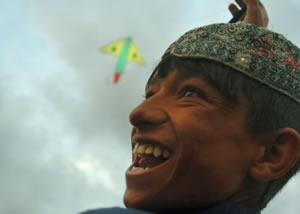Entries in Kiting in the News (36)
Kites Soar Above Political Turmoil
 In one of the most dramatic recent examples of kites bridging geo-political divisions, comes a story from the border between Egyptand the Gaza strip in Palestinian territory.
In one of the most dramatic recent examples of kites bridging geo-political divisions, comes a story from the border between Egyptand the Gaza strip in Palestinian territory.
A news report by journalist Mohammed Omer, on the web site of the Inter Press Service International Association located in Rome, Italy, shows the power of kites to focus people on matters other than war and widely differing politics.
The story, entitled "Kites Rise Above Divisions" outlines how two young boys, one in Egypt and the other in Gaza, are able to reach above the dividing wall of the border and challenge one another in a test of skill and maneuverability. Even though the boys cannot see one another, as they look skyward they are able to recognize one another's kites by their construction and the approximate place on the ground from which they are flown.
Differing economic conditions point are still visible in the sky, Mohammed Omer notes, as the sails on kites from Gaza are made of newspaper and plastic bags while the kites of the Egyptian boys are made of traditional materials like colorful tissue paper and glue.
In the sky, the challenge is on - boys playing with one another in a test of wills and wits with a simple desire to enjoy the opportunities of a playful diversion and better a friendly adversary in a non-life threatening manner.
Mohammed Omer's story is not an isolated incident of kites soaring above the border with children engaging in skillful competition in the sky. The occurrence of kite flying contests between children from Gaza and Egypt happens on a regular basis.
In a dramatic blog posting on May 17, 2007 by Laila El-Haddad, a journalist mother who divides her time between Gaza and the United States, the contrasts between war and the peaceful activity of children flying kites on both sides of the Egypt-Gaza border are clearly outlined. Laila El-Haddad wrote about one such day of contrasts thus:
"After a terrifying 24 hours, we awoke this morning to sporadic gunfire, and ghostly streets."
"Though the gunfire had subsided, the gunmen were still patrolling the streets, each this time casually manning their own turf, masked and fully armed."
"We decided to avoid the town centre, and headed instead to film near the border area along Rafah’s edge. Young children blissfully flew handmade kites above the iron wall separating them from the Egyptian Rafah. Their "atbaq" flirted in the infinite sky above with kites flying their way from the Egyptian side. "We play a game with the Egyptian kids" they explained of their unseen counterparts. "We meet here, through our kites, and see who can catch the other's kites quicker by entangling. So far we're winning-we've got 14 Egyptian kites" he announced proudly."
"The children are small enough that they can wiggle their way through the cracks of the large iron gates along the wall-where once Merkava tanks made their unwelcome entrance to battered camps here. And so they can call out to their Egyptian friends, and learn their names and new kite flying techniques."
So it is with kites - their ability to reach into the sky, to ride on the wind, to challenge each flyer to master the currents and the capabilities of their own tethered aircraft will always rise above the seemingly intractible divisions of geopolitical differences.
It makes one wonder if we should have more adults flying kites rather than grinding on with the same old politics.
At least while flying a kite they would look up, see the sky and feel the pull of the wind. The sky knows no borders and the wind does not stop at border crossings. The friendly challenges of skill allows one to learn of your counterpart in terms other than politics and opens a window on the possibility of seeing your opponent as an individual, rather than a stereotypical member of group politics. Perhaps there are serious lessons to be learned through kites!
__________________
Notes:
- Kites flown by children in Egypt and Gaza tend to be of the generic, maneuverable single line 'fighter kite' type. Usually the sail is made of tissue paper with bamboo or similar shapable wooden spars for framing. Sometimes, newspaper or plastic bags are substituted for sail material if the more expensive tissue paper is not available.
- Kites made of more modern ripstop sailcloth material can sometimes be found in the sea coast tourist areas of Egypt.
- The Egyptian sea coast resorts are popular spots for tourists who engage in the expensive sport of kite boarding using modern kites by Naish and designs by Peter Lynn.
The "Kite" Enshrined As A Universal and Enduring Toy
Toys build physical and mental skills; foster creativity and imagination; encourage critical and strategic thinking; teach fair play and cooperation; connect kids and adults; hold memories and provide windows into the past; reflect the ideas, beliefs, values, and attitudes of their creators and users; reveal historical change; predict the future; educate and entertain.
Kites and the Whitney Museum of American Art
 The Whitney Museum of American Art is mounting an exhibition sometime in the future that will focus on Alexander Graham Bell. The exact date of the exhibit has not yet been announced.
The Whitney Museum of American Art is mounting an exhibition sometime in the future that will focus on Alexander Graham Bell. The exact date of the exhibit has not yet been announced.While Bell has never been viewed as an 'artist', the museum feels that his work as recorded in his many notebooks utilized artistic expression to detail his ideas and concepts that were under development at various stages in his career as an inventor.
Bell was famous for including sketches and diagrams of his concepts. Many of his original sketches of his "ring" and "tetrahedral kites" are well known to kite historians, but they have not been widely revealed to the public.
I was pleased to be asked by Kristen France of the Whitney curatorial staff to assist with research on Bell's work with kites and the development of powered aircraft. The detailed research notes that I provided have been used to track down original photographs stored in the Library of Congress, the National Archives of Canada, and at the Alexander Graham Bell Museum in Baddeck, NS.
You can read more about the history of the Whitney Museum at:
http://www.whitney.org/www
Bell's Tetrahedral Kite - Centennial Celebrations
 One hundred years ago, on December 6, 2007, Alexander Graham Bell launched his largest tetrahedral kite, the Cygnet II, over the waters of Bras d'Or lake in Cape Breton, Nova Scotia. Towed behind a steam powered boat and carrying Lieut. Thomas Selfridge as passenger and to some degree pilot, the Cygnet was a milestone in the history of the development of flight and one of the most significant events in Canadian kite history.
One hundred years ago, on December 6, 2007, Alexander Graham Bell launched his largest tetrahedral kite, the Cygnet II, over the waters of Bras d'Or lake in Cape Breton, Nova Scotia. Towed behind a steam powered boat and carrying Lieut. Thomas Selfridge as passenger and to some degree pilot, the Cygnet was a milestone in the history of the development of flight and one of the most significant events in Canadian kite history.
A great deal of attention is being paid to the tetrahedral kites of Dr. Bell during this centennial celebration year marking the historic flight of the huge Cygnet. It certainly is a time to pause and remember the amazing ingenuity of the era as humans searched for the best ways to lift people into the sky in a safe and controlled manner.
Bell's intention was to use the inherently strong tetrahedron as a building block for an 'aerodrome' (aircraft) that would eventually be powered by a gasoline engine and achieve independent flight under the control of a pilot.
The Halifax Chronicle Herald ran a feature story on the work of Bell's Aerial Experiment Association, a group of five engineer-scientist fellows. The group was funded with a $30,000 investment provided by Mabel Bell, Dr. Bell's wife, who acted as the group's Secretary-Treasurer.
Uplifting dream was born century ago
Within 18 months, Bell-led group had Silver Dart in Baddeck sky
By TERA CAMUS Cape Breton BureauThe ChronicleHerald.ca October 1, 2007
BADDECK — It was 100 years ago today when it all began.
High on the hill overlooking Baddeck Bay, Alexander Graham Bell invited four men to his estate to begin working on a dream that would literally take flight 18 months later, in 1909.
Backed with $30,000 from Mr. Bell’s wealthy socialite wife Mabel, five creative minds forged a partnership known as the Aerial Experiment Association after the famous, aging inventor convinced them they could take flight in an aircraft after experimenting with large kites on and over his Baddeck estate.
"It’s amazing to think that for thousands and thousands of years, we couldn’t fly and within 18 months, bang, we’re flying among the stars," Mr. Bell’s great-grandson, Hugh Bell Muller, told The Chronicle Herald inside the Kite House where the five men constructed the aircraft.
Mr. Muller and his wife still walk on the original floorboards of that former barn, now renovated into a comfortable home, where Alec Bell, as he was known locally, worked with British immigrant Douglas McCurdy, a resident of Baddeck, and Toronto’s Casey Baldwin, both expert engineers. He also invited United States Lt. Thomas Selfridge and Glenn Curtiss, a New Yorker who built engines.
All five men lived in "the big house," better known as Beinn Bhreagh, which now is only open in summers for Mr. Bell’s direct descendants.
"In Bell’s time, he knew all the scientists," Mr. Muller said. "As a kid, he dreamed about flying while watching the birds."
The Wright Brothers, who had proved an aircraft could lift off using a catapult method, were busy in the United States trying to understand how to maintain flight.
"Bell was concerned with two things, the first was safety and the other was stability of controls to maintain a flight," Mr. Muller said. "Ms. Bell told him: ‘The five of you get an airplane in that air’ and it took 18 months to get the Silver Dart."
The first aircraft built in the Kite House in 1907 was the Cygnet, but it had no engine. It carried Selfridge for seven minutes and 51 metres and "flew beautifully" before it crashed into the water below Mr. Bell’s estate.
Moving on from the Cygnet, Bell and the five members of the AEA built four powered airplanes that were stable and reliable in flight. The culminating aircraft was the famous "Silver Dart" which was the first airplane to fly in the British Commonwealth of Nations when it lifted off the frozen waters of Bras d'Or Lake on February 23, 1909.
During this centennial celebration year of the massive Cygnet kite, a special commemorative kite fly was organized by the Canadian Kite Federation/Federation Canadienne du Cerf-Volant amd the Drachen Foundation of Seattle WA. The event was held on the Bell estate at Beinn Bhreagh overlooking Bras d'Or Lake in Baddeck, Nova Scotia on August 21, 2007.
Gary Mark of CKF/FCCV and Scott Skinner of the Drachen Foundation were instrumental in putting together the kite fly tribute to Bell's work with the Cygnet kite. More information can be found in an excerpt from the web site of the Drachen Foundation. A terrific video of interviews with Gary Mark, principal organizer of the event, and Hugh Muller, great-grandson of Alexander Bell is found on a special video clip at YouTube. Another interesting video clip is the CBC-TV Newsworld live broadcast of the event, also at YouTube.
In the autumn of 2004, CBC ran a television series entitled: The Greatest Canadian. Alexander Graham Bell was one of the featured candidates for the title of the greatest Canadian. I had the privilege of working on the production of that television show along with my good friend Gary Mark. To read about that story you can see an earlier posting in the Best-Breezes blog that detailed Bell's tetrahedral kites and see how a kite was included in the video taping for the show.
In the web site section of Best-Breezes, you can find more detailed information on Bell's Cygnet kite, the aerodromes of the Aerial Experiment Association, and a variety of other references on Bell's work with kites and aircraft. Be sure to check out the article entitled: Alexander Graham Bell: After the Telephone - Tetrahedral Kites, Airplanes and Hydrofoils.
One hundred years later the memory of Alexander Graham Bell's giant tetrahedral kites still lifts the imagination and makes the spirit soar!
Afghan Kites Get a Lift from European Troops - Patang! Patang!
 Kites returned to most areas of Afghanistan after the Taliban government left office in 2002 when American troops entered the country. The Taliban had banned kite flying as a frivolous and 'non-Islamic' activity. Kites again took to the skies in the nation's capital, Kabul, right after the exit of the Taliban regime.
Kites returned to most areas of Afghanistan after the Taliban government left office in 2002 when American troops entered the country. The Taliban had banned kite flying as a frivolous and 'non-Islamic' activity. Kites again took to the skies in the nation's capital, Kabul, right after the exit of the Taliban regime.
Some areas of Afghanistan remained under local Taliban influence long after a new government was installed in Kabul. In these areas, kite making and kite flying were still not permitted.
Recently, the Polish Battle Group, part of a coalition force that is patrolling parts of Afghanistan in support of the new government, entered Ghazni province’s Andar district. Here, kite flying was still banned due to the local influence of Taliban sympathizers.
Since there is a strong tradition of kite making and kite flying in the Afghan culture (see previous stories in this Blog), the Polish troops came equipped with kites to aid them in making friends with the local residents.
Speaking to Black Anthem Military News, Polish Pfc Chris Demko reported:
“It seems like time stopped here 2,000 years ago. We see these kids running around with nothing, not even shoes, and we want to change that.”
Everywhere they went, children crowded around the vehicles as the smiling soldiers pulled out boxes of shoes, clothes, school supplies and toys. But the biggest hit of all were the multi-colored kites that the soldiers unfolded for them.
With big grins and excited chattering, the children jumped up and down shouting, “Patang! Patang!” (the Pashto word for kite.)
Soon the sky had several of the yellow, green and red kites with International Security Assitance Forces logos flying, much to the delight of the children dancing around below.
“These kites are so much fun,” said Mahmad-Amid Hahn, a 12-year- old boy, as he made whooping sounds while his kite dipped and swerved in the air. “The Taliban would never give us these things.”
For the children who had never seen a kite before, some of the Polish soldiers stepped in to assist, unfolding the kites and showing them how to take off with a running start to get it airborne.
In addition to the kites, the Polish forces distributed food, clothing, medical supplies and school supplies in an effort to assist the local people.
The kites that quickly climbed into the skies, however, seemed to be a large symbol that things had changed in the region.
_________________
Photo credit: U.S. Army photo by Spc. Micah E. Clare





